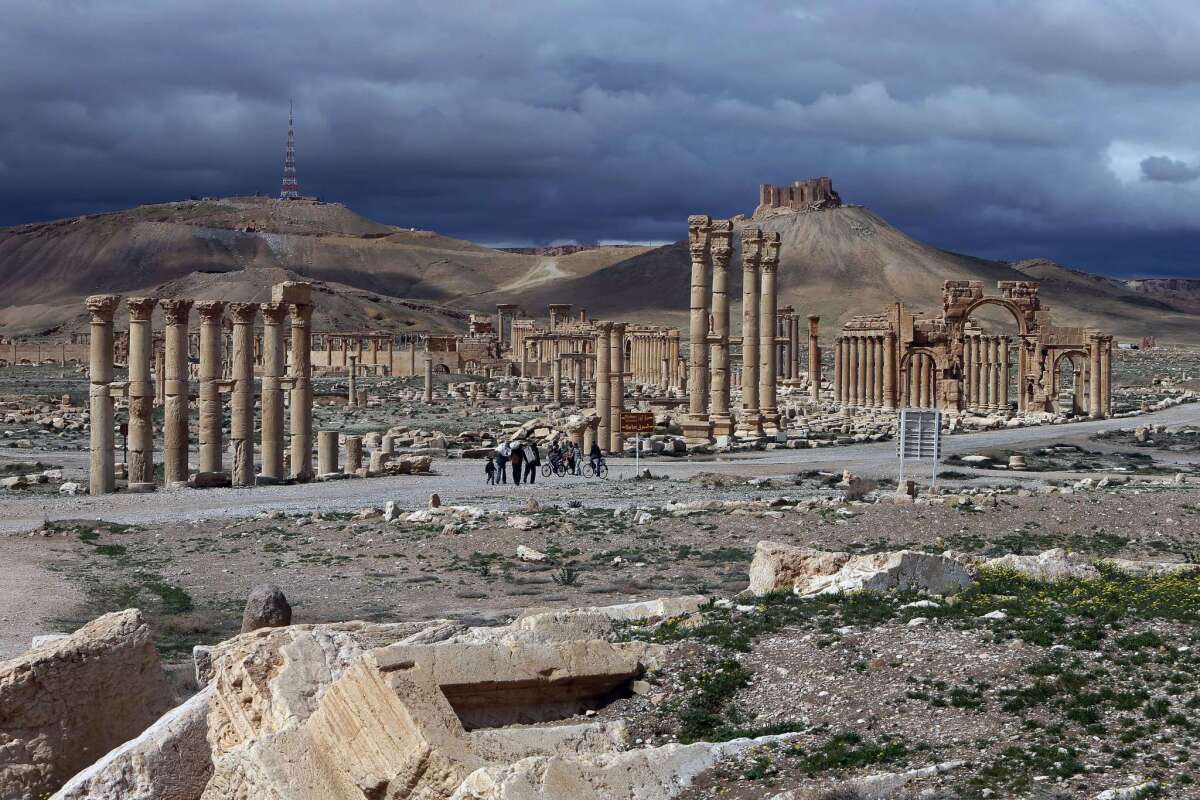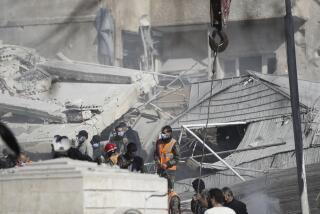A walk through the ruins of ancient Palmyra, before Islamic State

A photo from March 2014 shows the citadel, in the background, of the ancient oasis city of Palmyra, Syria.
The guide had tears in his eyes as he stood in the remains of the majestic temple of Bel, an ancient deity, the edifice’s stately columns gouged with holes as a result of recent shelling. We had the ruins of Palmyra, one of the globe’s awe-inspiring wonders, to ourselves — along with half a dozen plainclothes cops from Syrian intelligence who watched our backs, their pistols and submachine guns at the ready.
“I haven’t been here to the ruins in two years,” said the guide, Salem Kayem, a slim, soft-spoken school teacher and father of two, whose emotion was overcoming him. “It will take a long, long time to recover. Tourism is dead. No one comes to Palmyra. What we have come to know as Syria is lost.”
His grief was about more than the forsaken status of an archaeological site, albeit one of world-class pedigree. The comments seemed to encapsulate a collective anguish and incomprehension, so widespread in Syria, about the fate of a homeland that had somehow plunged into an unfathomable abyss.
This was more than a year ago, in April 2014, at a time when the Syrian military had pushed back Islamic insurgents and was in full control of the archaeological gem and the adjoining town.
This week, Islamic State militants seized control of Palmyra, also known as Tadmur, routing Syrian forces and paving the way for the unthinkable: the possibility that militants would begin destroying the historic metropolis and its transcendent assemblage of colonnaded streets, evocative temples, stately arches and a stunning amphitheater.
The militants call their destruction of cultural sites a strike against idolatry; more likely it’s shock PR by a social media-savvy group that thrives on pushing the envelope on global outrage, be it via beheadings, mass killings or taking sledgehammers, power drills and dynamite to historical and religious icons. The United Nations calls it cultural cleansing.
If they opt to destroy the site, the ultra-fundamentalists would, ironically, be following in the footsteps of the Roman emperor Aurelian, who crushed a 3rd century revolt lead by Palmyra’s fabled and rebellious queen, Zenobia, according to historical accounts. He later razed the city.
::
I had visited Palmyra a decade before, on a break from covering the war in neighboring Iraq. At the time, the contrast between the stability and safety of Syria and the mayhem and menace of Iraq was a hard thing to grasp. Back then, tour buses were parked outside the entrance to Palmyra; French tourists wearing broad hats against an unforgiving sun swarmed about like busy bees, judging everything “Formidable! (Wonderful!).”
Last year, however, there were no tourists, and authorities deemed an armed entourage a necessary precaution for visiting journalists. One couldn’t argue with their logic. Shards of shrapnel still littered the grounds. Months earlier, officials said, antigovernment guerrillas had used the site and adjoining stands of palms as a base. The local police force had lost 25 of its 87 men in the fighting, a police official said.
But the government was keen to demonstrate that it had taken seriously its caretaker role.
“We are preserving this site for all of humanity,” the mayor of Palmyra, accompanied by his son and bodyguards, told us as he ushered us into the museum in the adjoining town of Tadmur. “Palmyra is a treasure for the world, not just for Syria.”
Stone heads and statues were arrayed haphazardly on the floor of the museum. Scores of other priceless treasures had been taken away for safekeeping, authorities said. Glass cases were empty. Many artifacts had already been looted as law and order had broken down. Traffickers participating in the antiquities trade — now booming throughout Syria — were also digging up booty in the vicinity of Palmyra, much of which remains unexcavated.
A security officer later told us how lawmen had recently busted an antiquities ring, eavesdropping on the traffickers’ cellphone calls. The smugglers had buried stolen relics from Palmyra at a spot near the Iraqi border and planned to sell them in Iraq.
“These guys are really pretty dumb,” the security man said. “They steal pieces worth tens of thousands of dollars and they sell them for $25 or so.”
::
Downed power lines and vast expanses of scrubland lined the mostly deserted highway along the 100-mile desert route to Palmyra from the broken city of Homs, hardly a secure metropolis itself in 2014.
Once a major thoroughfare to the oil and gas fields of the east and the Iraqi border, the Homs-Palmyra highway has seen few motorists since the war began. Lonely roads in war zones, like abandoned streets in sniper territory, are generally to be avoided; no one is venturing out for a reason. We kept the gas pedal on the floor.
About midway to Palmyra, we heard the screech of fighter jets overhead, close to what appeared to be a government installation. It was a bit ominous. Soon, a pickup truck ferrying a few gunmen came barreling toward us. The pickup had a machine gun set up in the back, technical style. The Syrian flag meant that it was a pro-government unit, alone out here in a vulnerable stretch, without backup for some reason. The driver gestured for us to stop.
“Did you guys see anything?” asked the breathless driver, decked out in military fatigues and a checked head scarf.
“Why are you asking us?” replied our driver. “Did you see anything?”
We went our respective ways. Later, we heard that there had been a rebel attack along the main road; fortuitously, we had taken a slight detour, though more by misdirection than out of clever planning.
At the final checkpoint before Palmyra, an armed plainclothes security detail met us. The boss (he didn’t want his name used for security reasons) was a tough, mustachioed figure in a leather jacket, a stereotypical intelligence man who wasn’t to be messed with; but he was welcoming, and had a sense of humor.
His right-hand man was Ali, a reedy twentysomething with green eyes. We were ushered into the sleepy town and put up for the night in the spartan but comfortable confines of the Bel Hotel, with a view of the nearby Roman-Greco columns emerging from the archaeological park.
Across the street, the owners of souvenir shops that hadn’t seen business in ages beckoned us to have a look at their wares. The proprietor of one emporium bursting with every manner of bauble and faux artifact spoke of the good old days, when Palmyra was on the global hip-tour track, and of his many friends in Europe, America and beyond.
“Everyone came to Palmyra,” he said wistfully.
It was getting late and the plan was to enter the ruins the next morning. After our visit to the museum we were escorted through the animated town of Tadmur where hundreds of people were on the street, enjoying the cool evening. Our escorts stared down a few hostile looks. The intel chief seemed pretty well known, and probably feared. Tadmur is notorious as the site of a prison housing many Islamist radicals and antigovernment activists.
The security guys took us a to a storefront where a bearded shopkeeper in a greasy smock dispensed arak, the anise-flavored spirit of the Levant, in clandestine fashion; this was a devout Sunni town where alcohol was frowned upon. But the cops, part of the secular security establishment, approved. We dined at a kebob shop and went to a cafe where young men, many wearing Barcelona T shirts, were watching a soccer match.
The next morning, we started early for the ruins, accompanied by our security detail. We wandered about as we withered beneath the searing sun. The damage from shelling and bullets to many of the temples and columns was evident; however, the harm did not appear major. All of the monuments seemed intact.
To have a place like Palmyra practically to oneself is an extraordinary feeling. The place is overwhelming, the very definition of the word monumental.
Our guide, Kayem, was a walking encyclopedia, a 15-year veteran of the Palmyra tour gig.
“I am a bit rusty,” he said apologetically in English at the outset, but that proved not to be the case, as he methodically explained every detail, architectural and historical.
It was hard to keep a clear head. Mostly I recall the overwhelming grandeur of the place, this great oasis city and caravan stop at the crossroads of several civilizations, where a defiant queen took on the Romans, and paid the price.
The trip back to Homs was uneventful. There were more mortar rounds and gunfire in the evening, that town’s habitual late-night sound track. But it felt reassuring to know that Palmyra had been preserved and that, someday, visitors would again be able to find inspiration its splendor.
As it turns out, that may have been wishful thinking.
Follow me on Twitter at @mcdneville
More to Read
Start your day right
Sign up for Essential California for news, features and recommendations from the L.A. Times and beyond in your inbox six days a week.
You may occasionally receive promotional content from the Los Angeles Times.






